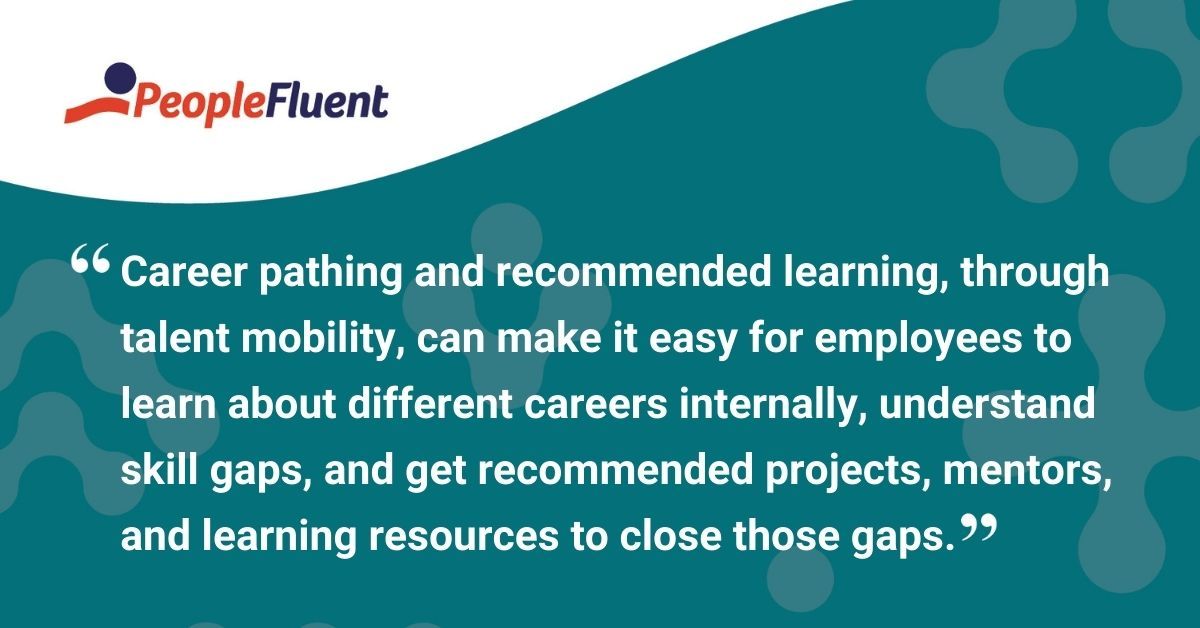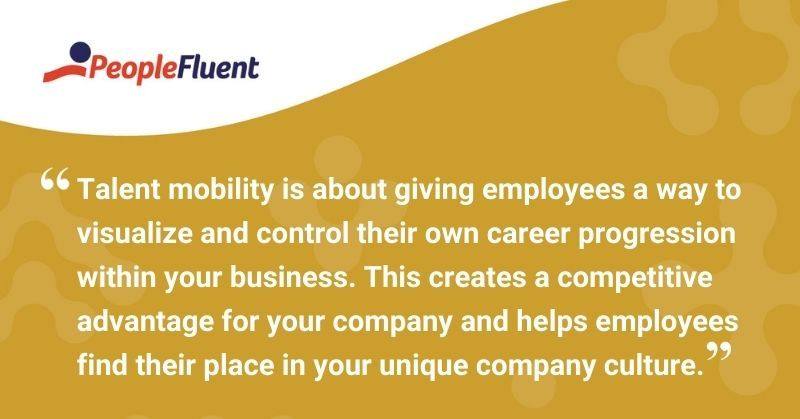Published: Mar 3, 2021Time to read: 6mins Category: Insights
The 5 Pillars of a Successful Talent Mobility Strategy and How to Leverage Them
Table of Contents
On a recent webinar, ‘Talent Mobility 101: Mentoring, Career Pathing, Skills Gaps and More…’, we discussed the many moving parts of talent mobility In this article, find timely information about the five pillars of talent mobility and why they’re important for your organization right now.
You can also watch a copy of the 45-minute webinar at your leisure.
What Is Talent Mobility and Why Is It a Priority?
Talent mobility is the organization’s ability to quickly understand the skills, experiences, and career interests of employees in order to more effectively move them into new roles internally where existing skills can be sharpened and new skills can be developed.
FOR A DEEPER DIVE, CHECK OUT THIS BLOG POST | ‘What Is Talent Mobility? Plus, What It’s Not!’
Talent mobility is a priority now due to three main drivers:
- Lack of career development is now the number-one cause of employee turnover. Based on a research report from Work Institute, the main reason for employees leaving is a lack of career development. The growing skill gap is creating opportunities externally when people can’t find them inside their own organization.
- Companies are now reorganizing for agility. According to Mercer’s 2021 Global Talent Trends report, HR must be focused on finding new ways of working in an effort to be more agile.
- The workforce is now demanding growth opportunities. When surveyed by Deloitte, Millennials (a generation that makes up a majority of today's workforce), stated training and skills development play an important part in their long-term career prospects.
A strong talent mobility strategy can elicit big results. And without one, it can be detrimental to your organization’s bottom line, causing $45 million in staff turnover and recruiting costs annually for a mid-sized company (10,000 employees at a 6% voluntary turnover). Estimates of the financial burden to replace staff vary, but here’s one stat worth noting: the cost of finding a replacement for an individual employee can be as much as 2x the employee's annual salary.
READ MORE | '3 Easy Ways Talent Mobility Can Increase the Effectiveness of Learning'
When to Re-Think a Talent Mobility Strategy
If your HR department is actively running exit surveys or employee pulse surveys, you might notice that career mobility is a point of contention. Employees might note that they don’t have options to grow and build new skills within the business. This could lead them to a decrease in productivity—or worse, result in an increase in staff turnover.
A solution lies in the confluence of talent mobility and learning programs as often, L&D pros can identify where gaps are and who may be interested in career progression before HR teams or internal recruiters can.
A few high-level reasons to look at rethinking your talent mobility strategy include:
- struggling to retain employees
- lacking visibility into career pathing or opportunities
- little to no visibility into employee skills experience, and career aspirations
- learning content is not targeted to employee career aspirations and skill gaps
- no career pathing, mentorship, or project/gig work available

What Are the 5 Pillars of Talent Mobility?
To be effective, a talent mobility program should focus on career pathing, open jobs and internal recruiting, workforce analytics, as well as projects and mentor marketplaces.
Below, we’ll expand on how you can take advantage of these pillars:
1) Career Pathing and Recommended Learning
Career pathing and recommended learning, through talent mobility, can make it easy for employees to learn about different careers internally, understand skill gaps, and get recommended projects, mentors, and learning resources to close those gaps.
2) Open Jobs and Internal Recruiting
Employees receive open job recommendations and recruiters are alerted when employees are recommended for open positions, making the internal recruiting process smooth. This function also allows recruiters to proactively notify and push jobs to encourage employees to apply.
3) Projects Marketplace
The project marketplace provides a one-stop-shop for employees to explore and participate in projects as it recommends projects based on skill and skill gaps. Once matched to a project, the line manager and employees can communicate directly in the platform.
YOU MIGHT ALSO LIKE | 'Upskilling vs. Reskilling: Understanding the Differences and Their Role in Talent Mobility'
4) Mentor Marketplace
A mentor marketplace is a matchmaking platform where employees can offer their knowledge, skills, and experiences coupled with the availability to easily find other workers who are seeking mentorship. It provides mentor recommendations when employees are trying to connect with someone based on their career aspirations and skill gaps. Once matched, the mentor and mentee can liaise in the platform on upcoming projects or topics to discuss.
5) Workforce Analytics
Workforce analytics provides talent insights such as career aspirations, skills, and development gaps. Organizational skills insights, like strengths and gaps in talent, are also available.

How to Start the Talent Mobility Conversation Internally
Developing a successful strategy begins with strong internal communication. Start with asking questions to stakeholders, HR professionals, and employees. Here are a few to get you started:
- How do we describe our talent mobility or talent marketplace strategy currently?
- How do we do career pathing today?
- Is learning tied to our career paths today and if so, how?
- What options do our recruiters currently have for sourcing talent internally?
- How do we manage mentorships and how do employees find mentors?
- How do we facilitate employees finding internal gig or project work?
- What visibility does HR have into the skills and gaps of your organizational talent?
These types of discussions can lead to whether your organization is ready to develop a talent mobility program and whether it’s time to bring in a talent mobility solution. Keep in mind that at its crux, talent mobility is about giving employees a way to visualize and control their own career progression within your business. This creates a competitive advantage for your company and helps employees find their place in your unique company culture.

KEEP READING | 'Do You Know How to Find the Bright Lights in Your Organization?'